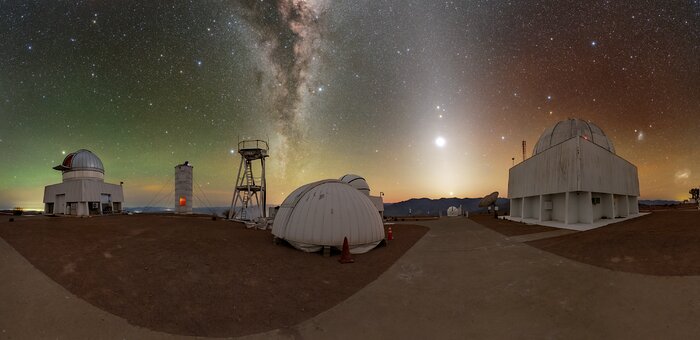A Duality of Dust
Two lines of light — one the arm of our Milky Way and the other zodiacal light — rise parallel to each other from the horizon above U.S. National Science Foundation Cerro Tololo Inter-American Observatory (CTIO) in this Image of the Week. CTIO is a Program of NSF NOIRLab situated in the high, dry environment of the remote mountain of Chile, where sensitive equipment can capture the subtleties of light in our night sky.
Between the DIMM1 Seeing Monitor and decommissioned CHilean Automatic Supernova sEarch (CHASE) is one arm of our galaxy. Its glow, formed by unresolved stars and other material, is obscured here and there by dark patches, made up of vast amounts of dust and gas. To the right of the Milky Way is the faint glow of zodiacal light, sunlight that is being scattered by interplanetary dust left over from the formation of our Solar System. This line outlines the ecliptic, the orbital plane traversed by the planets in our Solar System, since most of this dust resides along this plane. The plane is clearly delineated by the planets ‘inside’ the zodiacal light: skyward from the horizon are Jupiter, Venus, Mars, and Saturn.
Other telescopes featured in this image are (left to right) the US Naval Observatory Deep South Telescope, DIMM2 Seeing Monitor, aTmCam (Atmospheric Transmission Monitoring Camera), and SMARTS 1.0 meter telescope.
This photo was taken as part of the recent NOIRLab 2022 Photo Expedition to all the NOIRLab sites. Tomáš Slovinský, the photographer, is a NOIRLab Audiovisual Ambassador.
Credit:CTIO/NOIRLab/NSF/AURA/T. Slovinský
About the Image
| Id: | iotw2414a |
| Type: | Photographic |
| Release date: | April 3, 2024, noon |
| Size: | 13000 x 6321 px |
About the Object
| Name: | aTmCam, DIMM1 Seeing Monitor, DIMM2 Seeing Monitor, SMARTS 1.0-meter Telescope, US Naval Observatory Deep South Telescope |
| Category: | Chile |
